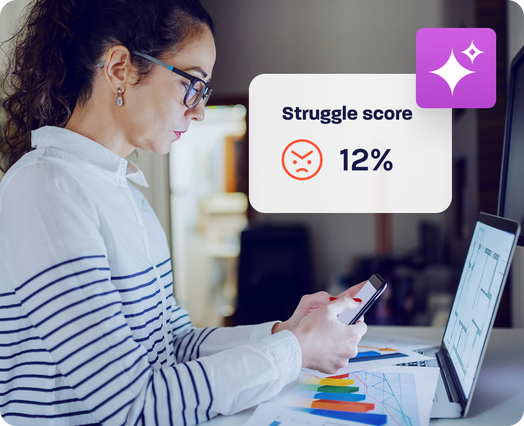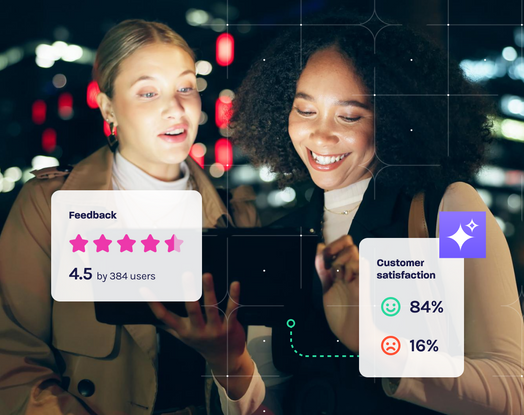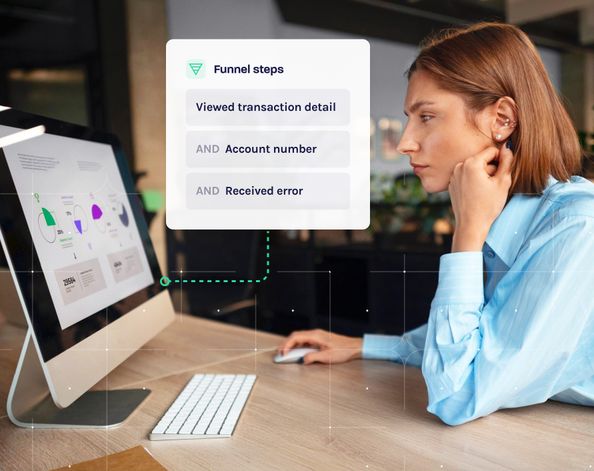
Mastering Conversion Funnel Optimization: Boost Conversions and Reduce Friction
Every click your users engage in—or don’t—has a cost. Even a tiny friction point in your website or app can mean lost revenue, missed leads or abandoned carts. Conversion funnel optimization has morphed from a nice-to-have strategy into an urgent necessity for businesses that want to stay competitive.
By analyzing each stage of the customer journey, mapping user behavior and pinpointing bottlenecks, you can uncover exactly why visitors drop off, which actions drive engagement and where the journey can be streamlined for maximum results. Key metrics like drop-off rates, conversion rates and engagement points reveal actionable insights that help businesses optimize websites, apps and digital experiences to boost conversions, improve user experience and drive ROI.
This article will break down the process of conversion funnel optimization, highlight common friction points, share practical tips for improving digital journeys and show how businesses across industries can turn insights into measurable results.
Understanding Conversion Funnels: Stages, Metrics and Digital Journeys
A digital conversion funnel outlines each stage of the customer journey—from awareness, interest and consideration to action—showing how visitors progress toward a desired outcome. Each step is designed to guide users seamlessly to the next stage, whether it’s a purchase, sign-up or content download. By analyzing the funnel, businesses can identify bottlenecks, optimize messaging and ensure a smooth path to conversion.
Examples of Conversion Funnels Across Industries
There are a variety of conversion funnels designed for websites and apps, but they all share the common goal of getting the user to convert to the specified goal, such as purchase, trial, content download, etc.
Here’s a sampling of different types of digital conversion funnels across industries:
E-commerce store conversion funnel
Financial product purchase funnel
Content download funnel
Charitable donation funnel
Healthcare appointment booking funnel
Travel booking funnel
SaaS free trial or onboarding funnel
B2B lead generation funnel
Conversion Funnel Optimization: The Benefits of Optimizing Each Stage of the Customer Journey
Conversion funnel optimization offers several benefits for businesses. Here are the top six:
1. Increased Conversion Rates
Boosting conversions is good for business. You’re acquiring new buyers and attracting returning customers to nurture for more sales and loyalty. Optimizing conversion funnels through consistent and data-driven analysis enhances user engagement while reducing churn. It also helps you build a library of best practices to apply across other funnels and supports experimentation through A/B testing.
Tip: Use A/B testing on landing pages, simplify checkout flows, and personalize calls-to-action to guide users smoothly to the next step in the funnel and maximize conversions.
2. Improved ROI
Increasing your conversion optimization rate means more visitors convert without increasing traffic, giving you a better return on your marketing investment. By analyzing which funnel optimizations perform best and where your highest-converting customers come from, you gain insights that lower customer acquisition costs and increase lifetime value.
Tip: Track the sources of your top-converting users, optimize those high-performing pathways and focus on strategies that reduce acquisition costs while maximizing customer lifetime value.
3. Enhanced User Experience
Understanding the customer journey through the lens of conversion funnel optimization reveals how users interact with your digital channels. Analyzing each step helps identify pain points, uncover user preferences and highlight UX elements that improve—or detract from—the experience. These insights guide smarter decisions around design updates, content refinements and feature enhancements.
Tip: Leverage session replay and interaction maps to spot struggles and refine the user experience across industries, from travel booking platforms to SaaS onboarding flows.
4. Better Targeting and Segmenting
Analyzing conversion funnels by segment provides powerful insights into audience behavior. You can identify your highest-converting customers, tailor funnels to specific personas, job titles or demographics, and uncover why other users aren’t converting. This approach enables more precise marketing and optimized customer journeys across channels.
Tip: Examine vertical-specific funnels—such as healthcare, B2B, or SaaS—to deliver personalized content and offers that resonate with segmented audiences and improve conversion rates.
5. Data-Driven Decision Making
Grounding your optimization efforts in real user behavior—not assumptions or trends—creates a stronger foundation for growth. Data-driven insights empower teams to prioritize changes, test hypotheses and continuously refine the conversion funnel. This approach ensures every improvement is measurable, targeted and aligned with actual user needs.
Tip: Track metrics like drop-off rates, engagement points and conversion velocity to identify where users hesitate and where optimizations will have the greatest impact.
6. Continuous Improvement
Conversion funnel optimization is never one-and-done. It’s an ongoing process of testing, learning and refining. As products, customer expectations and marketing strategies evolve, so should your funnel. Regular analysis ensures your digital experience stays aligned with both user needs and business goals.
Tip: Continuously refine your funnels with experimentation, usability testing and feedback loops to stay agile and maintain steady conversion growth over time.
How To Analyze and Optimize Your Funnel
Analyzing and optimizing the digital conversion funnel has many benefits for customer success, but it’s also a core part of doing business online. Here are three main reasons
1. Streamline the Funnel
A potential customer making their way through the conversion funnel wants to go from one action to the next without delays or distractions. Analyzing each step a customer takes in the funnel (or doesn’t take) can help to reveal ways to streamline the path for a higher conversion rate. For example, you may want to display fewer pop-ups along the way, cut an unnecessary navigation step or make other optimizations based on analytics.
2. Pinpoint Behavioral Frustrations
It’s critical to know why potential customers are struggling during the conversion funnel, leading to actions such as hitting the back button or leaving your site or app altogether. For instance, if you’re getting a big drop-off at the last step of a conversion, you'll want to determine the cause. Is the purchase button broken? Are they being directed to the wrong page? Is your total cost not displayed? Uncovering the data, getting answers and taking action are key.
3. Get Stakeholder Team Efforts in Sync
Data analysis technology delivers deep insights needed for conversion funnel optimization, but it’s the teams and their actions with those rich insights that make the difference. For example, engineering can build better products, marketing can craft higher-impact promotions and CX teams can develop new customer service processes based on feedback. Strong cross-collaboration also helps build a better digital customer experience overall.
Common Friction Points in Digital Funnels and How To Fix Them
Identifying and resolving friction points through conversion funnel analysis is crucial to improving conversion rates. Even small usability issues can disrupt momentum and drive users away. Here are the most common bottlenecks and tips on how to fix them:
Checkout Friction
In an e-commerce conversion funnel, long or complex checkout processes, mandatory account creation or slow-loading pages can derail purchases.
Streamline the checkout flow by offering guest checkout options, auto-filling form fields and minimizing the number of steps. Use performance monitoring to ensure pages load quickly across all devices.
Form Abandonment
Overly lengthy or confusing forms can disrupt the conversion process and cause users to exit before completion.
Simplify forms by removing unnecessary fields, providing real-time validation and clearly communicating why information is needed. Consider progress indicators to reassure users that they are close to completion.
Unexpected Fees or Charges
Hidden costs at the final step often result in last-minute drop-offs and a higher bounce rate.
Be transparent early. Display shipping, taxes or service fees upfront to build trust. Test pricing displays and checkout copy to minimize surprises.
Confusing Navigation or Unclear CTAs
Users may leave if it’s not clear what action to take next in the marketing funnel.
Clarify the next step with visually distinct, action-oriented CTAs, such as “Start Free Trial” or “Book Now,” and ensure consistent navigation across pages. Utilize click and scroll maps to identify where users hesitate or get lost.
By pinpointing these friction points, businesses can implement targeted improvements through conversion rate optimization—simplifying checkout flows, testing alternative landing pages or personalizing user journeys to reduce abandonment.
Primary Causes of Abandonment Within Conversion Funnels
Let’s take a look at some of the primary causes of user abandonment: errors, struggles and missed expectations.
Errors That Cause Drop-Off
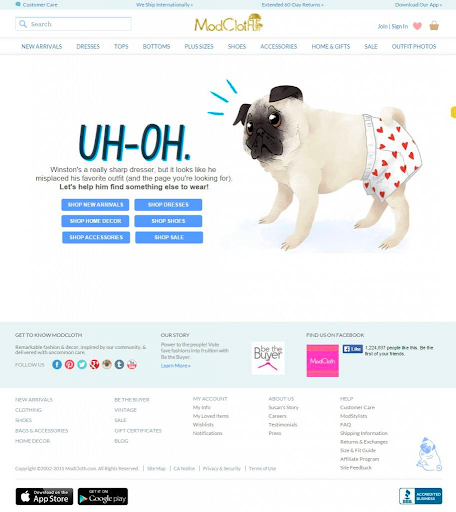
Identifying and eliminating errors can often be one of the easiest ways to optimize the funnel and prevent users from abandoning a purchase or conversion.
Often, users who encounter an error will try again, either right away or at another time. But if the error persists, or if they have to invest a lot of time in each attempt, they may not be so forgiving.
Depending on the nature, severity and frequency of the error, some of these users may still attempt one of your organization’s other channels, but even with this option, there are extra costs involved and increased potential that you may lose this opportunity.
In prioritizing which errors to resolve first, consider:
How often do they occur?
How many users are impacted?
How critical is it to the process?
What is the potential revenue that could be achieved if this error weren’t a roadblock?
What resource challenges will you face in getting it resolved?
User Struggles That Block Conversions
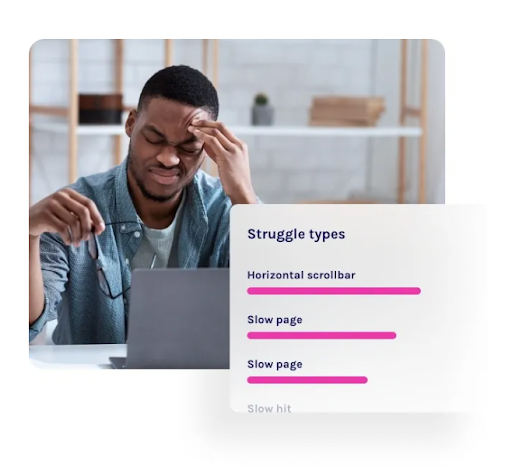
Even if users don’t encounter “show-stopping” errors, they’re still an abandonment risk if they’re having difficulty. The more users struggle at a specific step in the process, the more likely they will abandon your site or app.
For example, if users don’t understand what the next step is supposed to be or are confused by the options presented, they may still make a few attempts, but they’re likely to abandon at some point during the process due to frustration.
To gain a deeper understanding of these challenges, it’s important to identify the patterns of struggles first. Behaviors that will elicit the context behind struggles include exhibiting signs of frustration, such as rage clicking a button, reloading pages, frequently referring back to your in-line “tips” or help pages and entering the wrong values into fields, or skipping fields altogether, to name some struggle symptoms.
Analyzing these user actions will help you determine and prioritize which struggles you will want to eliminate. This is also a good opportunity to experiment with alternative design options in an A/B testing and optimization program to monitor and measure for improvements.
Missed Expectations and How To Meet Them
While errors and struggles are clear issues for users, there’s a more subtle but just as important cause of abandonment: unmet expectations. When a potential customer isn’t getting the outcome they anticipated, they’re likely to leave your website or app–whether it’s in the beginning stage or the cart.
👉🏻Check out these 5 proven strategies to reduce shopping cart abandonment.
These reasons can include the cost, terms, extra fees, availability and customer reviews, just to name a few. Sometimes the customers’ needs simply aren’t met, and they leave. For example, a potential customer won’t hang around filling out an insurance or a credit application after they’re informed it’s not available in their area.
👉🏻While we’re on the topic, check out these 10 insurance customer retention strategies for long-term success.
These types of mismatches can be headed off by providing early detection to inform the customer of this limitation so that they don't waste time. Or, it might be possible to route them to a partner or subsidiary for their needs and turn the abandonment into an alternative conversion event. These are often harder to detect (and correct) than some other reasons for abandonment, but the aggregated data may provide insight and identify helpful correlations.
For example, you may observe that users from certain regions are more likely to have a higher abandonment rate. Or perhaps you can compare the average purchase amounts for users who do convert to the average cart value of users who abandon and realize that it’s only high-end customers who are abandoning.
While these are some of the major causes of abandonment, they’re not the only ones. A better understanding of these elements will help you maximize conversions and deliver funnel optimization recommendations.
Abandonment, no matter what the cause, is a high-priority area in conversion funnel optimization. One very effective and efficient method of uncovering, analyzing and prioritizing errors is adopting a digital experience intelligence (DXI) platform. With features like session replay, interaction maps, struggle scores, journey analytics and other advanced capabilities, you can get to the cause, prioritize fixes based on the business impact and resolve problems faster.
6 Steps to Creating an Effective Funnel Optimization Program
Creating a well-structured funnel optimization program is a critical step for online success. Focusing on the customer journey through the various stages lets businesses systematically refine their digital pathways, ultimately leading to increased conversions and improved customer satisfaction. In this section, we’ll explore the essential steps and strategies for establishing an effective funnel optimization program that delivers tangible results.
First, start by defining your strategy and goals. Clearly define the objectives you want to achieve with your website or mobile app conversion funnel optimization program. Identify the key actions or conversions that align with your business objectives. For example, it could be completing a purchase, signing up for a newsletter or filling out a form. This will also be based on your industry, business KPIs, selling model and other unique factors.
Here are some common digital conversion funnel optimization questions to ask:
What do you want the person to do at the end of the conversion funnel? (purchase, get a trial, etc.)?
What funnel metrics are you tracking? (volume, churn, conversions, etc.)
Is it a B2B business to nurture for the long haul or a faster B2C conversion like an airline ticket purchase?
Which audience segment are you targeting in the funnel? (prospect, new customer, returning customer, multiple, etc.)
Below are the six steps to go through to create a funnel optimization program:
Map out your funnels: Identify the critical user funnels or flows that lead to your defined goals. Break down these journeys into stages or steps, starting from the initial interaction to the final conversion step. Each stage represents a milestone in the user's journey, such as a landing page visit, product selection or checkout process.
Set up tracking: Implement a robust analytics system to track user behavior at each stage of the funnel. Use event tracking, page view tracking or other relevant methods to capture user actions and interactions. Ensure that the tracking is accurately implemented and aligned with your defined goals and funnel stages.
Analyze user behavior: Collect and analyze data from your tracking system to gain insights into user behavior within the funnel. Examine the conversion rates at each stage, identify drop-off points and understand user flow throughout the journey. Look for patterns, trends and areas of improvement.
Identify bottlenecks and optimization opportunities: Based on your analysis, identify stages in the funnel where users are dropping off or experiencing difficulties. Investigate the potential causes, such as usability issues, confusing navigation or technical errors. Use this information to optimize those stages and improve overall conversion rates.
Iterate and test: Continuously monitor and analyze the performance of your funnels. Implement A/B testing, usability testing and user feedback to validate improvements and improve on your optimization efforts. Make data-driven decisions to enhance the user experience and maximize conversions.
Measure and refine: Regularly track and measure the performance of your funnels. Use key metrics such as conversion rates, drop-off rates and average time spent to evaluate the effectiveness of your optimizations. Refine your funnels based on the data and insights gathered, aiming for continuous improvement.
Advanced Funnel Analysis With DXI
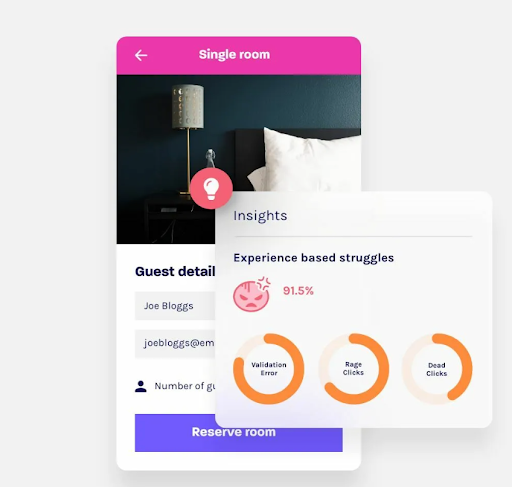
With a DXI platform, there are advanced funnel analysis functions to surface specific types of funnel insights, so you can prioritize and resolve issues faster.
Funnel Alerts for Conversion Ratio Changes
Accessing real-time data from customer journeys can be configured to alert you to bugs and issues before they become a major problem. Once identified, you can pinpoint where the problem is.
Funnel Struggle Insights With Session Replay
With features like session replay, you can get a video-like reconstruction of a user's journey on your website or app, uncovering causes of funnel abandonment, such as browser issues, errors and other struggles.
Integrating the Voice of the Customer (VoC)
Voice of the customer (VoC) and other surveys can be meaningful, but when you can integrate that feedback with session replays, it can offer invaluable insights. You’ll also know exactly where they were in the conversion funnel when feedback was obtained and why.
Retroactive Analysis Provides Better Context
Because an advanced DXI platform can capture 100% of events with tagless data capture, you can view historical data and build ad-hoc funnels from prior data to visualize various outcomes.
Optimizing the Conversion Funnel With Glassbox
Mastering conversion funnel optimization requires both insight and action. By analyzing each stage of the funnel, identifying friction points and continuously testing and refining digital pathways, businesses can significantly improve conversions, engagement and ROI.
Glassbox’s advanced digital experience intelligence DXI platform helps uncover the “why” behind friction points through session replay, interaction maps, struggle scores and journey analytics. These capabilities enable teams to see exactly where and why users drop off, prioritize fixes and implement improvements that create seamless, high-converting customer experiences.
See how you can quickly quantify digital experience issues with Glassbox funnel analytics. Schedule a demo today to see how Glassbox can transform your funnel optimization efforts.





